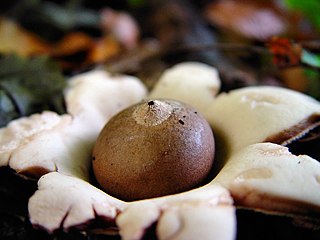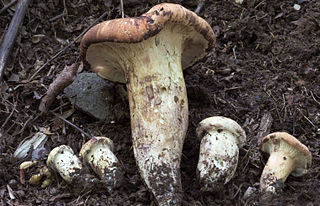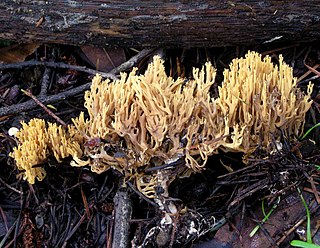
Geastrales is an order of gasterocarpic basidiomycetes (fungi) that are related to Cantharellales. The order contains the single family Geastraceae, which includes the "earthstars" formerly placed in Lycoperdales, or Phallales.

The Agaricales are an order of fungi in the division Basidiomycota. As originally conceived, the order contained all the agarics, but subsequent research has shown that not all agarics are closely related and some belong in other orders, such as the Russulales and Boletales. Conversely, DNA research has also shown that many non-agarics, including some of the clavarioid fungi and gasteroid fungi belong within the Agaricales. The order has 46 extant families, more than 400 genera, and over 25,000 described species, along with six extinct genera known only from the fossil record. Species in the Agaricales range from the familiar Agaricus bisporus and the deadly Amanita virosa to the coral-like Clavaria zollingeri and bracket-like Fistulina hepatica.

Gomphus is a genus of cantharelloid fungi in the family Gomphaceae. Once presumed to be related to chanterelles, molecular study has shown them to be allied with stinkhorns and fairy clubs. The type species of the genus is the pig's ear (G. clavatus).

The Gomphales are an order of basidiomycete fungi. Some or all families belonging to Gomphales have been sometimes included in the order Phallales, the now-obsolete Ramariaceae was also previously included in Cantharellales. Recent phylogenetic analyses include in Gomphales the families of the original description of the order by Walter Jülich, with addition of Clavariadelphaceae. According to one 2008 estimate, the Gomphales contain 18 genera and 336 species.

Turbinellus floccosus, commonly known as the scaly vase, or sometimes the shaggy, scaly, or woolly chanterelle, is a cantharelloid mushroom of the family Gomphaceae native to Asia and North America. It was known as Gomphus floccosus until 2011, when it was found to be only distantly related to the genus's type species, G. clavatus. It was consequently transferred from Gomphus to Turbinellus. The orange-capped vase- or trumpet-shaped fruiting bodies may reach 30 cm (12 in) high and 30 cm (12 in) wide. The lower surface, the hymenium, is covered in wrinkles and ridges rather than gills or pores, and is pale buff or yellowish to whitish.

Gomphus clavatus, commonly known as pig's ears or the violet chanterelle, is an edible species of fungus in the genus Gomphus native to Eurasia and North America. The fruit body is vase- or fan-shaped with wavy edges to its rim, and grows up to 15–16 cm wide and 17 cm tall. The upper surface or cap is orangish-brown to lilac, while the lower spore-bearing surface, the hymenium, is covered in wrinkles and ridges rather than gills or pores, and is a distinctive purple color. Described by Jacob Christian Schäffer in 1774, G. clavatus has had several name changes and many alternative scientific names, having been classified in the genus Cantharellus, though it is not closely related to them.

The Carbomycetaceae are a family of fungi in the order Pezizales. The family contains the single genus Carbomyces, which in turn contains three species distributed in the United States and Mexico.

Gloeocantharellus is a genus of fungi in the family Gomphaceae. It contains 12 species that are found in mainly tropical and subtropical regions.

Ramaria flaccida is a species of coral fungus in the family Gomphaceae. Originally described as Clavaria flaccida by Elias Fries in 1821, the species was transferred to Ramaria by Hubert Bourdot in 1898.

Phaeoclavulina abietina, commonly known as the green-staining coral, is a coral mushroom in the family Gomphaceae. It is characterized by the green staining reaction it develops in response to bruising or injury.

Turbinellus is a genus of five species of fungi in the family Gomphaceae.

Ramaria cokeri is a coral mushroom in the family Gomphaceae. It was described in 1976 from the Appalachian Mountains in the United States. Some authors have proposed to place the species in a separate genus Phaeoclavulina based on molecular analyses, but this was explicitly rejected in a subsequent publication due to the resulting morphological variability of the resulting genus.
Gomphus brunneus is a species of fungus in the genus Gomphus, family Gomphaceae. It has been recorded from rainforest in the Yucatan Peninsula in Mexico, as well as Uganda and Democratic Republic of Congo in Africa.
Gomphus crassipes is a species of fungus in the genus Gomphus, family Gomphaceae. It is native to Spain and North Africa and possibly threatened by habitat loss.

Turbinellus kauffmanii, is a species of mushroom native to North America.
Turbinellus stereoides, previously known as Gomphus stereoides, is a mushroom in the family Gomphaceae. It was originally described in 1996 by E. J. H. Corner as a species of Gomphus. The type collection was made in 1930 in Slim River, Malaysia.

Ramaria myceliosa is a species of coral fungus in the family Gomphaceae. Found in North America, it was originally described by Charles Horton Peck in 1904 with the name Clavaria myceliosa. The type was collected by botanist Edwin Bingham Copeland in the mountains near Stanford University in California. E.J.H. Corner transferred it to the genus Ramaria in 1950. Giachini and colleagues proposed that Ramaria myceliosa is the same species as the European Phaeoclavulina curta, but did not provide molecular evidence to support their suggested synonymy. In a recent (2014) publication on California fungi, the authors propose the transfer of Ramaria myceliosa to the genus Phaeoclavulina, but as of January 2016, this transfer has not been accepted by either MycoBank or Index Fungorum.
Turbinellus flabellatus is a species of fungus in the family Gomphaceae. To date, this species has only been recorded from Japan.













